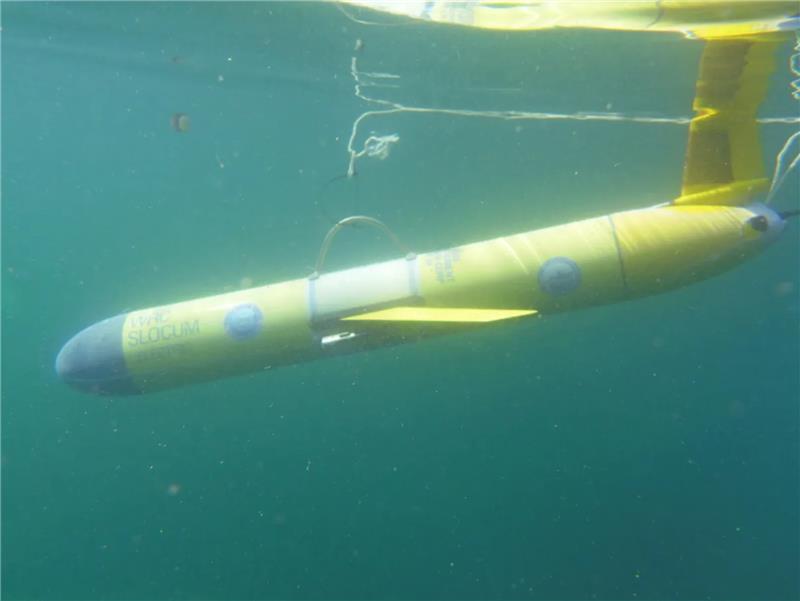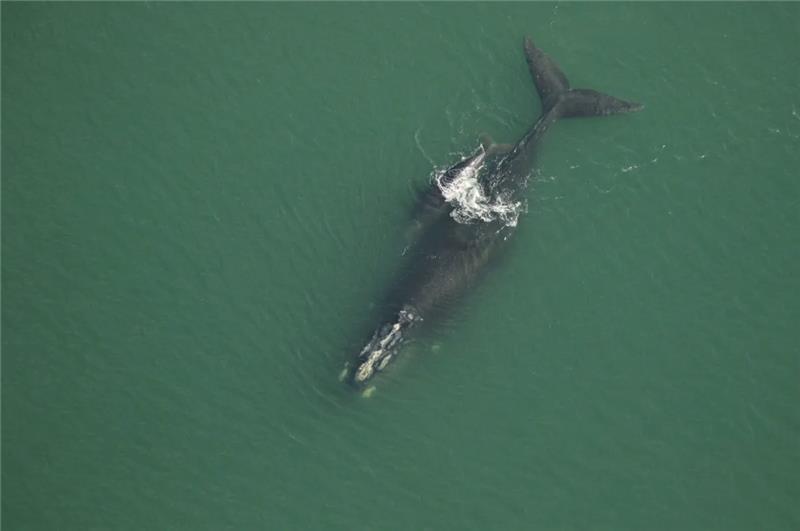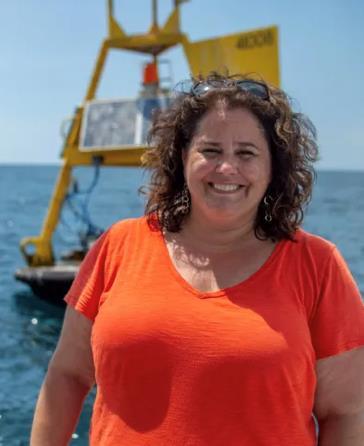
Section Branding
Header Content
Underwater robot deployed to aid endangered right whales
Primary Content

With spring well underway, the North Atlantic right whales that migrated to Georgia to give birth here over the winter have migrated back north to their feeding grounds off New England and Canada. Researchers know from aerial surveys that at least 16 calves were born in the 2022-23 season.
But scientists don’t just look for whales, they listen for them, too. And this year they added an underwater robot to the listening platforms in Georgia.
In late January, Skidaway Institute of Oceanography scientist Catherine Edwards deployed a torpedo-shaped glider called Argus to eavesdrop on these endangered whales as they swam near the port of Savannah. Edwards paired up with University of South Carolina researcher Erin Meyer-Gutbrod, who led the team that listened to the recordings in near real time.
“Catherine is sort of the genius driving the glider around,” Meyer-Gutbrod said. “And we’re the ones that are actually trying to parse out noise from whale detection.”
There are only about 340 North Atlantic right whales remaining. Starting around November each year, the adult females migrate from their summer feeding grounds up north to reach their winter calving grounds off Georgia and Florida.
Right whales are nicknamed “urban whales” for their propensity to hug the shoreline of the East Coast where so much of the U.S. population resides. As they migrate, they run a dangerous gauntlet of shipping lanes, recreational boats and heavily fished regions. In just the last six years, at least 11 right whales have been killed by ship strikes. Two more were seriously injured.
That’s where they eavesdropping underwater robots come in. Edwards and Meyer-Gutbrod are listening for whales so they can alert shippers and recreational boaters to their presence.
Vessels bigger than 65 feet are already required to slow to 10 knots in certain areas when it’s calving season. Voluntary speed restrictions are in place, too. But all are routinely ignored. Studies have shown a less than 10 percent compliance for ships coming in to the Savannah port.
And those same aerial surveys that identify newborn calves by crisscrossing Georgia’s near shore waters from about mid-November to April share whale sightings with mariners. But that information is expensive to produce and less than comprehensive. Bad weather grounds the planes and the whales can only be sighted when they surface.
Ears in the water are a possible solution. Edwards deployed her robot from Jan. 30 to Feb. 13 this year. The yellow glider zig-zagged up and down through the water by changing its buoyancy and center of gravity. Without a motor, it’s relatively quiet, making it ideal for whale listening. Equipped with a satellite phone, the glider surfaced every four hours to transmit recorded data to base stations on land.

“During that deployment, we got eight detections of right whales that were verified by our team on shore, which is really, really, really cool,” Edwards said.
A hydrophone on the glider picks up the sounds and transmits them to a web site called Robots 4 Whales at the Woods Hole Oceanographic Institute. A machine learning algorithm sorts out what it identifies as whale sounds. Meyer-Gutbrod and three of her graduate students verified the whale calls.
Along with the 15 days’ worth of glider-detected whale calls, there are stationary hydrophones attached to buoys collecting data around the clock for the past year.
The scientists are comparing the effectiveness of the mobile and moored hydrophones and trying to work out how far away from the robot a whale can be detected. They’d eventually like to use these tools to help alert ship captains in real time when whales are nearby.
“We’re hoping that if we alert vessel captains in real time it’s going to increase the likelihood that they’re going to comply with the vessel speed,” Meyer-Gutbrod said.
(A cell phone app called WhaleAlert already can be used to alert vessel captains that whales have been sighted or heard recently in an area.)
Challenges abound. Among them is that is that mother calf pairs are believed to be pretty quiet.
“First of all, she’s mostly communicating with her calf, who’s right next to her, you know, like touching distance, because they’re constantly nursing,” Meyer-Gutbrod said. “So there’s no reason to project their voice. But I would also imagine, and we don’t have any way to prove it, but that the mom, with this vulnerable newborn doesn’t really want to draw a lot of attention to herself.”

There’s also a concern that mariners could misinterpret a lack of detected whale calls to mean the whales aren’t present. That’s not necessarily the case.
“We can’t tell you when they’re not there,” Edwards said. “There’s evidence that right whales go quiet, sometimes, related to human activity.”
Calving season wrapped up in April with 16 calves born. One of those is already known to have died. Researchers suggest more than 20 calves must be born each year to keep the population going.
“Unfortunately, they’re not reproducing fast enough to counteract the harmful effects humans are having on the population,” Edwards said. “So, each year they decline and decline.”
But the listening work has already proven useful, Meyer-Gutbrod said.
“We’re doing the analysis for a buoy just offshore of Norfolk, Virginia. We heard some right whales pretty unexpectedly a few weeks ago because usually they’re thought to be back up north by now,” she said earlier in May. “And so NOAA instituted a temporary slow down zone in the area around that buoy.”
The researchers also want to study recent changes in whale migration patterns. A decline in the food supplies during the summer months has triggered a shift in the North Atlantic right whale’s foraging grounds from the Gulf of Maine northward to the Gulf of St. Lawrence. While surveys have documented this shift, scientists have not yet assessed its impact on winter migration patterns.
They expect to have their glider back in the water in December.
The project is funded by a $196,847 grant from the Broad Reach Fund. The researchers are aiming to redeploy the glider in December after the right whales return to Georgia for the calving season.
This story comes to GPB through a reporting partnership with The Current.

